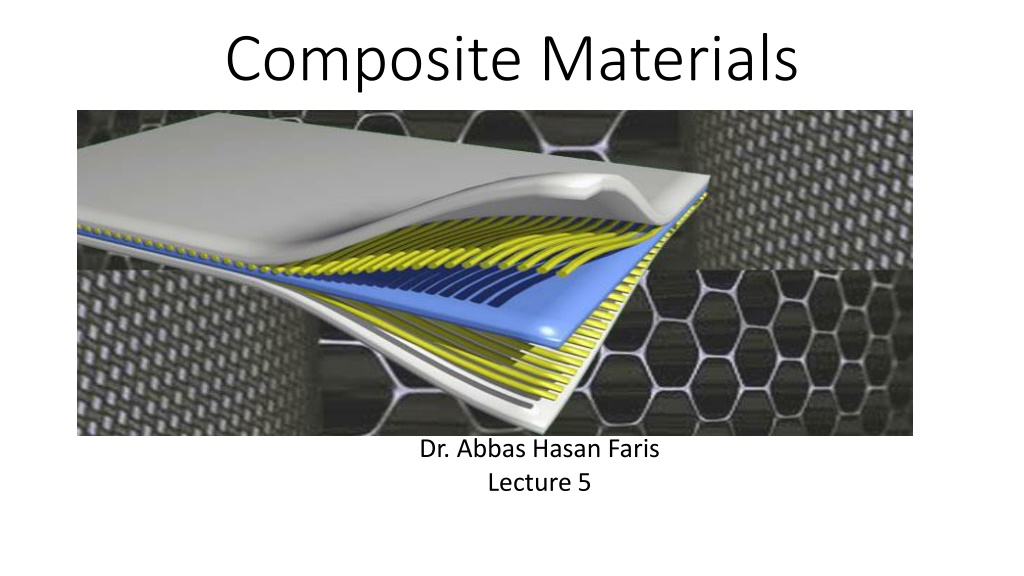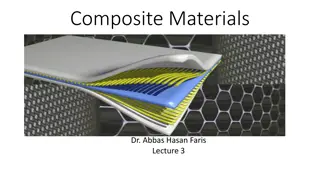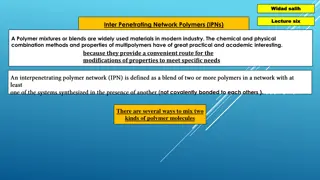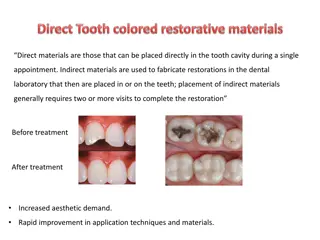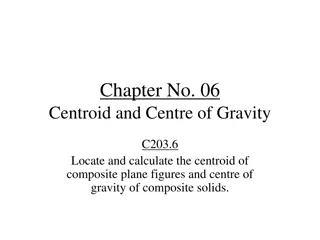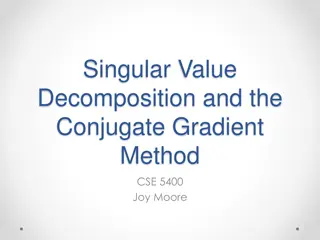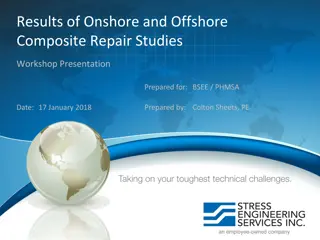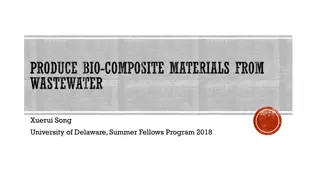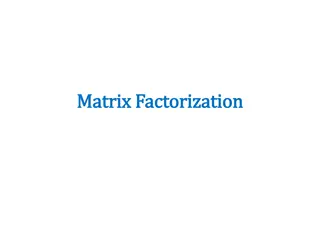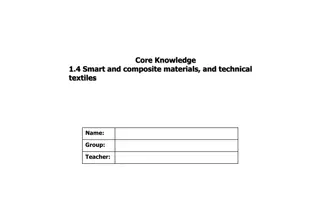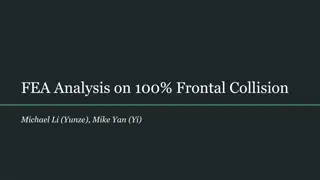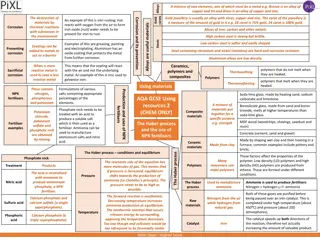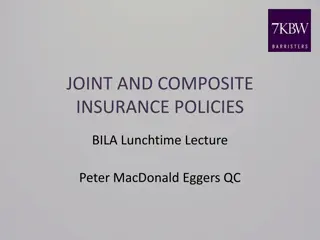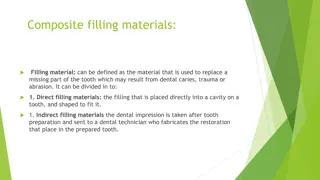Understanding Composite Matrix Materials in Engineering
Composite materials are made of reinforcing fibers and matrix materials, with the matrix serving to protect and enhance the properties of the composite. There are three main types of composite matrix materials: metal matrix composites (MMC), ceramic matrix composites (CMC), and polymer matrix composites (PMC). Each type has specific applications and advantages. Matrices play a crucial role in binding reinforcements, offering protection, distributing loads, and improving overall material properties. Understanding the functions and types of composite matrix materials is essential in engineering applications.
Download Presentation

Please find below an Image/Link to download the presentation.
The content on the website is provided AS IS for your information and personal use only. It may not be sold, licensed, or shared on other websites without obtaining consent from the author. Download presentation by click this link. If you encounter any issues during the download, it is possible that the publisher has removed the file from their server.
E N D
Presentation Transcript
Composite Materials Dr. Abbas Hasan Faris Lecture 5
MATRIX As discussed, composites are made of reinforcing fibers and matrix materials. The matrix is basically a homogeneous material in which a fiber system of a composite is embedded. It is completely continuous. Matrix surrounds the fibers and thus protects those fibers against chemical and environmental attack. For fibers to carry the maximum load, the matrix must have a lower modulus and greater elongation than the reinforcement. Matrix selection is performed based on chemical, thermal, electrical, flammability, environmental, cost, performance, and manufacturing requirements. The matrix determines the service operating temperature of a composite as well as processing parameters for part manufacturing. . Types of Composite Matrix Materials:- There are three main types of composite matrix materials: 1- Metal matrix composites (MMC) 2- Ceramic matrix composites (CMC) 3- Polymer matrix composite (PMC)
The functions of a matrix:- 1. binding and holding reinforcements together into a solid 2. offers protection to the reinforcements from environmental damage 3. Protects the reinforcements from abrasion 4. Helps to maintain the distribution of reinforcements 5. Distributes the loads evenly between reinforcements 6. Enhances some of the properties of the resulting material and structural component (that fiber alone is not able to impart). These properties are such as: transverse strength of a lamina Impact resistance 7. Provides better finish to final product
1- Metal matrix - Metal matrix composites (MMCs) are composite materials that contain at least two constituent parts a metal and another material or a different metal. The metal matrix is reinforced with other materials to improve strength and wear. Where three or more constituent parts are present, it is called a hybrid composite. In structural applications, the matrix is usually composed of a lighter metal such as magnesium, titanium, or aluminum. In high-temperature applications, cobalt and cobalt-nickel alloy matrices are common. Typical MMC manufacturing is basically divided into three types: solid, liquid, and vapor. Continuous carbon, silicon carbide, or ceramic fibers are some of the materials that can be embedded in a metallic matrix material. MMCs are fire resistant, operate in a wide range of temperatures, do not absorb moisture, and possess better electrical and thermal conductivity. They have also found applications to be resistant to radiation damage, and to not suffer from outgassing. Most metals and alloys make good matrices for composite applications.
2- Ceramic matrix - Ceramic matrix composites consist of ceramic fibers embedded in a ceramic matrix, thus forming a ceramic fiber-reinforced ceramic (CFRC) material. The matrix and fibers can consist of any ceramic material. CMC materials were designed to overcome the major disadvantages such as low fracture toughness, brittleness, and limited thermal shock resistance, faced by traditional technical ceramics. 3- Polymer matrix - Polymer matrix composites (PMCs) can be divided into two main sub-types, namely, thermoset and thermoplastic. A polymer is a large molecule composed of repeating structural units connected by covalent chemical bonds. PMC consists of a polymer matrix combined with a fibrous reinforcing dispersed phase. They are cheaper with easier fabrication methods. PMC is less dense than metals or ceramics, can resist atmospheric and other forms of corrosion, and exhibit superior resistance to the conduction of electrical current.
In general, metals and polymers are used as matrix materials because some ductility (flexibility) is desirable; for ceramic-matrix composites, the reinforcing component is added to improve fracture toughness. The matrix phase serves several functions First, it binds the fibers together and acts as the medium by which an externally applied stress is transmitted and distributed to the fibers; only a very small proportion of an applied load is sustained by the matrix phase. Furthermore, the matrix material should be ductile. In addition, the elastic modulus of the fiber should be much higher than that of the matrix. That s mean For fibers to carry the maximum load, the matrix must have a lower modulus and greater elongation than the reinforcement. The second function of the matrix is to protect the individual fibers from surface damage as a result of mechanical abrasion or chemical reactions with the environment. Such interactions may introduce surface flaws capable of forming cracks, which may lead to failure at low tensile stress levels. Finally, the matrix separates the fibers and, based on its relative softness and malleability, prevents the propagation of brittle cracks from fiber to fiber, which could result in catastrophic failure; in other words, the matrix phase serves as a barrier to crack propagation.
Polymer Matrix Composites (PMCs) Anymaterialcanserveas amatrixmaterialforcomposite. However, matrix materialsaregenerallyceramics, metals, andpolymers. Inreality, themajority ofmatrixmaterialsthatexistonthecompositesmarketarepolymer . A polymer is any of a class of natural or synthetic substances composed of very large molecules, called macromolecules, which are multiples of simpler chemical units called monomers. Polymers make up many of the materials in living organisms and are the basis of many minerals and man-made materials. Thermoplastics Tough; high melt viscosity; and recyclable Thermosets Brittle; low viscosity before cure; not recyclable
There are several different polymer matrices that can be utilized in composite materials. Among the polymer matrix composites, thermoplastic matrix composites are more dominant than thermoset composites. Though thermosets and thermoplastics sound similar, they have very different properties and applications. Understanding the performance differences can help to make better sourcing decisions and the product designs as composites. Thermosets are materials that undergo a chemical reaction or curing and normally transform from a liquid to a solid. In its uncured form, the material has small, unlinked molecules known as monomers. The addition of a second material as a cross-linker, curing agent, catalyst, and/or the presence of heat or some other activating influences will initiate the chemical reaction or curing reaction. During this reaction, the molecules cross-link and form significantly longer molecular chains and cross-link networks, causing the material to solidify. The change in the thermoset state is permanent and irreversible. Thereafter, exposure to high heat after solidifying will cause the material to degrade, not melt. This is because these materials typically degrade at a temperature below where they would be able to melt.
Thermoplastics are melt-processable plastics. Thermoplastic materials are processed with heat. When enough heat is added to bring the temperature of the plastic above its melting point, the plastic melts liquefies or softens enough to be processed. When the heat source is removed and the temperature of the plastic drops below its melting point, the plastic solidifies back into a glass-like solid. This process can be repeated, with the plastic melting and solidifying as the temperature climbs above and drops below the melting temperature, respectively. However, the material can be increasing subject to deterioration in its molten state, so there is a practical limit to the number of times that this reprocessing can take place before the material properties begin to suffer. Many thermoplastic polymers are addition-type, capable of yielding very long molecular chain lengths or very high molecular weights.
Thermoplastic: Soften upon heating and can be reshaped with heat & pressure Thermosetting: become cross linked during fabrication & do not soften upon reheating
Stagesof a cureforthermosetresin. (a) Polymerandcuringagentpriortoreaction. (b) Curingisinitiatedwith thesizeofmoleculesincreasing. (c) Gelationwithfullnetworkformed. (d) Fullcuredandcrosslinked.
Polymer Matrix Composites The Most Common Advanced Composites? The most common advanced composites are polymer matrix composites (PMCs) consisting of a polymer (e.g., epoxy, polyester, urethane) reinforced by thin diameter fibers (e.g., graphite, aramids, boron). For example, graphite/ epoxy composites are approximately five times stronger than steel on a weight for- weight basis. The reasons why they are the most common composites include their low cost, high strength, and simple manufacturing principles. 12
The Drawbacks Of Polymer Matrix Composites? The main drawbacks of PMCs include low operating temperatures, high coefficients of thermal and moisture expansion,* and low elastic properties in certain directions. The Typical Mechanical Properties Of Some Polymer Matrix Composites? Compare these properties with metals. Table blow gives typical mechanical properties of common polymer matrix composites. 13
Thermoplastics: polypropylene, polyvinyl chloride (PVC), nylon, polyurethane, poly-ether-ether ketone (PEEK), polyphenylene sulfide (PPS), Polysulpone higher toughness high volume low-cost processing Temperature range 225 C
Thermoplastics: Thermoplastics are increasingly used over thermosets becuase of the following reasons: Processing is faster than thermoset composites since no curing reaction is required. Thermoplastic composites require only heating, shaping, and cooling. Better properties: - high toughness (delamination resistance) and damage tolerance, - low moisture absorption - chemical resistance They have low toxicity. Cost is high
Thermosets: polyesters, epoxies, polyimides Other resins Epoxy Resin: Epoxy resins are widely used for most advanced composites. Epoxies are the most common matrix material for high-performance composites and adhesives. They have an excellent combination of strength, adhesion, low shrinkage, and processing versatility. Commercial epoxy matrices and adhesives can be as simple as one epoxy and one curing agent; however, most contain a major epoxy, one to three minor epoxies, and one or two curing agents.
The minor epoxies are added to provide viscosity control, impart higher elevated temperature properties, provide lower moisture absorption, or improve toughness. Two main major epoxies are used in the aerospace industry. The first is diglycidyl ether of Bisphenol A (DGEBA), which is used extensively in filament winding, pultrusion, and some adhesives. The second is tetraglycidyl methylene dianiline (TGMDA), also known as tetraglycidyl-4,4- diaminodiphe-nylmethane (TGGDM), which is the major epoxy used for a large number of the commercial composite matrix systems. The epoxy group, or oxirane ring, is the site of crosslinking:
Advantages: Low shrinkage during curing High strength and flexibility Adjustable curing range Better adhesion between fiber and matrix Better electrical properties Resistance to chemicals and solvents Disadvantages: somewhat toxic in nature limited temperature application range up to 175 C moisture absorption affecting dimensional properties high thermal coefficient of expansion slow curing
Common PMC Fibers & Matrices Fibers Graphite Glass Kevlar Matrices Epoxy Phenolic Polyester
